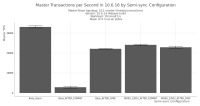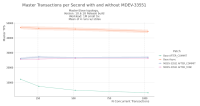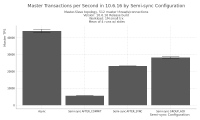Details
-
Bug
-
Status: Closed (View Workflow)
-
Major
-
Resolution: Fixed
-
10.5, 10.6, 10.11, 11.0(EOL), 11.1(EOL), 11.2(EOL), 11.3(EOL)
-
None
Description
Semi-sync Wait Point AFTER_COMMIT Slow on Workloads with Heavy Concurrency
When using semi-sync replication with rpl_semi_sync_master_wait_point=AFTER_COMMIT, the performance of the primary can significantly reduce to about 10% of AFTER_SYNC's performance for workloads with many concurrent users executing transactions. See the attached graph, where the "Async" bar reports the performance of a primary using asynchronous replication, the "Semi-sync AFTER_COMMIT" and "Semi-sync AFTER_SYNC" reports the performance of the primary using the respective rpl_semi_sync_master_wait_point variable, and "Semi-sync GROUP_ACK" is a prototype of the work outlined by MDEV-33491.
It can be seen that the performance of the AFTER_COMMIT mode of semi-sync is many times worse than that of the AFTER_SYNC mode. This is because all connections on the primary share the same cond_wait variable/mutex pair, so any time an ACK is recieved from a replica, all waiting connections are awoken to check if the ACK was for itself, which is done in a mutual exclusion zone. See the attached Semi-sync Group Ack Proposal PDF for more details.
Instead, each connection should use its own condition variable (e.g. THD::COND_wakeup_ready), and the ACK receiver thread should only signal connections which have been ACKed for wakeup.
Attachments
Issue Links
- causes
-
MDEV-34122 Assertion `entry' failed in Active_tranx::assert_thd_is_waiter
-
- Closed
-
-
MDEV-36359 Crash after disabling semi sync + start a master switchover process
-
- Stalled
-
- duplicates
-
MDEV-34462 SemiSync replication underperforming and stalling throughput
-
- Closed
-
- relates to
-
MDEV-33491 Semi-sync Replication Group ACK
-
- Stalled
-
Activity
| Field | Original Value | New Value |
|---|---|---|
| Link | This issue relates to MDEV-33491 [ MDEV-33491 ] |
| Attachment | semisync_patched.png [ 73209 ] |
| Status | Open [ 1 ] | In Progress [ 3 ] |
| Attachment | Semi-sync Group Ack Proposal.pdf [ 73210 ] |
| Description |
Semi-sync Wait Point AFTER_COMMIT Slow on Workloads with Heavy Concurrency
When using semi-sync replication with rpl_semi_sync_master_wait_point=AFTER_COMMIT, the performance of the primary can significantly reduce to about 10% of AFTER_SYNC's performance for workloads with many concurrent users executing transactions. See the attached graph, where the "Async" bar reports the performance of a primary using asynchronous replication, the "Semi-sync AFTER_COMMIT" and "Semi-sync AFTER_SYNC" reports the performance of the primary using the respective rpl_semi_sync_master_wait_point variable, and "Semi-sync GROUP_ACK" is a prototype of the work outlined by MDEV-33491. It can be seen that the performance of the AFTER_COMMIT mode of semi-sync is many times worse than that of the AFTER_SYNC mode. This is because all connections on the primary share the same cond_wait variable/mutex pair, so any time an ACK is recieved from a replica, all waiting connections are awoken to check if the ACK was for itself, which is done in a mutual exclusion zone. Instead, each connection should use its own condition variable (e.g. THD::COND_wakeup_ready), and the ACK receiver thread should only signal connections which have been ACKed for wakeup. |
Semi-sync Wait Point AFTER_COMMIT Slow on Workloads with Heavy Concurrency
When using semi-sync replication with rpl_semi_sync_master_wait_point=AFTER_COMMIT, the performance of the primary can significantly reduce to about 10% of AFTER_SYNC's performance for workloads with many concurrent users executing transactions. See the attached graph, where the "Async" bar reports the performance of a primary using asynchronous replication, the "Semi-sync AFTER_COMMIT" and "Semi-sync AFTER_SYNC" reports the performance of the primary using the respective rpl_semi_sync_master_wait_point variable, and "Semi-sync GROUP_ACK" is a prototype of the work outlined by MDEV-33491. It can be seen that the performance of the AFTER_COMMIT mode of semi-sync is many times worse than that of the AFTER_SYNC mode. This is because all connections on the primary share the same cond_wait variable/mutex pair, so any time an ACK is recieved from a replica, all waiting connections are awoken to check if the ACK was for itself, which is done in a mutual exclusion zone. See the attached Semi-sync Group Ack Proposal PDF for more details. Instead, each connection should use its own condition variable (e.g. THD::COND_wakeup_ready), and the ACK receiver thread should only signal connections which have been ACKed for wakeup. |
| Assignee | Brandon Nesterenko [ JIRAUSER48702 ] | Kristian Nielsen [ knielsen ] |
| Status | In Progress [ 3 ] | In Review [ 10002 ] |
| Attachment | semisync_mdev_33551.png [ 73216 ] |
| Assignee | Kristian Nielsen [ knielsen ] | Brandon Nesterenko [ JIRAUSER48702 ] |
| Fix Version/s | 10.6.18 [ 29627 ] | |
| Fix Version/s | 10.6 [ 24028 ] | |
| Fix Version/s | 10.11 [ 27614 ] | |
| Fix Version/s | 11.0 [ 28320 ] | |
| Fix Version/s | 11.1 [ 28549 ] | |
| Fix Version/s | 11.3 [ 28565 ] | |
| Fix Version/s | 11.2 [ 28603 ] | |
| Resolution | Fixed [ 1 ] | |
| Status | In Review [ 10002 ] | Closed [ 6 ] |
| Fix Version/s | 10.11.8 [ 29630 ] | |
| Fix Version/s | 11.0.6 [ 29628 ] | |
| Fix Version/s | 11.1.5 [ 29629 ] | |
| Fix Version/s | 11.2.4 [ 29631 ] |
| Attachment | semisync_mdev33551_patched.png [ 73298 ] |
| Link |
This issue causes |
| Zendesk Related Tickets | 164270 |
| Link |
This issue duplicates |
| Link | This issue causes MDEV-36359 [ MDEV-36359 ] |
| Labels | crash |
| Labels | crash |


